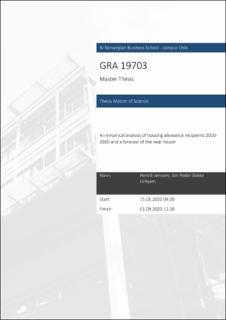An empirical analysis of housing allowance recipients 2010- 2020 and a forecast of the near future
Master thesis
Permanent lenke
https://hdl.handle.net/11250/2687278Utgivelsesdato
2020Metadata
Vis full innførselSamlinger
- Master of Science [1621]
Sammendrag
This study seeks to identify the attributes of recipients of housing allowance in
Norway and formulate an econometric model capable of predicting the inflow of
new recipients of housing allowance in the near future. As the Norwegian State
Housing Bank receives funding via the state budget, such a model will help to
ensure that the bank receives proper funding.
The study finds that the number of applicants, recipients and new recipients has
decreased significantly over the past ten years, despite that the number of people
considered poor in Norway has increased. Moreover, the anticipated effect of
income and housing expenses are minimalised through the politically decided
income and approved housing expenses limits. Furthermore, we find the inflow of
new recipients to be a function of previous inflow, average housing expenses, age,
regulations, employment, and unemployment. The chosen model to forecast the
inflow is Vector Autoregression (VAR) model. Moreover, through an Impulse
Response Function (IRF), we find that Regulation and Employment are the two
variables that has the greatest effect on the inflow of new recipients. The accuracy
of the model is tested by comparing the VAR forecast to a forecast with linear
regression and actual values. Moreover, it is evaluated using mean error (ME),
mean percentage error (MPE) root mean squared errors (RMSE), mean absolute
errors (MAE), mean absolute percentage errors (MAPE).
The study concludes that given the available data, the VAR model is able to
produce satisfactory results, although the precision and the usage of external data
can be better.
Beskrivelse
Masteroppgave(MSc) in Master of Science in Business Analytics- Handelshøyskolen BI, 2020
